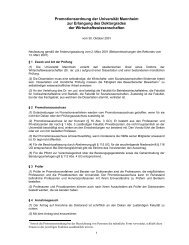The returns to cognitive and non-cognitive abilities in Germany
The returns to cognitive and non-cognitive abilities in Germany
The returns to cognitive and non-cognitive abilities in Germany
Create successful ePaper yourself
Turn your PDF publications into a flip-book with our unique Google optimized e-Paper software.
mean age is 38 years so that the <strong>in</strong>terdependency between concurrent school<strong>in</strong>g level <strong>and</strong> test<br />
scores is not given. <strong>The</strong> possible <strong>in</strong>terdependency between earn<strong>in</strong>gs <strong>and</strong> personality however<br />
is taken <strong>in</strong><strong>to</strong> account. Follow<strong>in</strong>g the approach of Nyhus <strong>and</strong> Pons (2005) <strong>and</strong> Osborne<br />
Groves (2005), each personality trait is regressed on age <strong>and</strong> age squared. <strong>The</strong> residuals from<br />
these regressions then are free from age effects. While far from be<strong>in</strong>g perfect, this will <strong>to</strong><br />
some extent pick up possible feedback effects of an <strong>in</strong>dividual’s job (<strong>and</strong> social)<br />
environment on her personality. <strong>The</strong> st<strong>and</strong>ardized scores of the IQ-test are processed<br />
similarly a) <strong>to</strong> keep the results <strong>and</strong> <strong>in</strong>terpretation consistent <strong>and</strong> b) <strong>to</strong> capture the negative<br />
age effects on fluid <strong>in</strong>telligence (Baltes et al., 1999). S<strong>in</strong>ce the result<strong>in</strong>g <strong>in</strong>dica<strong>to</strong>rs of<br />
personality <strong>and</strong> cognition can be taken as age-free, i.e. are constant over time, this approach<br />
further allows match<strong>in</strong>g this <strong>in</strong>formation <strong>to</strong> preced<strong>in</strong>g waves of the SOEP <strong>and</strong> apply<strong>in</strong>g<br />
appropriate panel estima<strong>to</strong>rs (see below).<br />
A further issue <strong>in</strong> the personality measures is that the variability <strong>in</strong> the result<strong>in</strong>g<br />
personality dimensions might arise from measurement error. To quantify this, <strong>and</strong> <strong>to</strong> be able<br />
<strong>to</strong> correct for it, Cronbach’s alpha reli<strong>abilities</strong> (Cronbach, 1951) are calculated. For the FFM<br />
dimensions, these are: openness 0.64, conscientiousness 0.65, extraversion 0.73,<br />
agreeableness 0.54, <strong>and</strong> neuroticism 0.63. For LOC we get: <strong>in</strong>ternal LOC 0.22, <strong>and</strong> external<br />
LOC 0.61, <strong>and</strong> the reliability ratios for positive <strong>and</strong> negative reciprocity are 0.66 <strong>and</strong> 0.83<br />
respectively. <strong>The</strong>se reliability coefficients ma<strong>in</strong>ly are low compared <strong>to</strong> what is typically<br />
found <strong>in</strong> the literature (John <strong>and</strong> Srivastava, 1999), where they range between 0.70 <strong>and</strong> 0.90.<br />
However, given that only three items per personality trait are available <strong>in</strong> the SOEP, the<br />
ratios found are satisfac<strong>to</strong>ry: Employ<strong>in</strong>g the Spearman-Brown formula, Mueller <strong>and</strong> Plug<br />
(2006) show that the reliability ratios <strong>in</strong>crease with an <strong>in</strong>creas<strong>in</strong>g number of items. 12 We<br />
however exclude <strong>in</strong>ternal LOC from the analyses, s<strong>in</strong>ce the alpha of 0.22 clearly <strong>in</strong>dicates a<br />
<strong>to</strong>o large measurement error mean<strong>in</strong>g that the surveyed items are not at all appropriate for<br />
16















